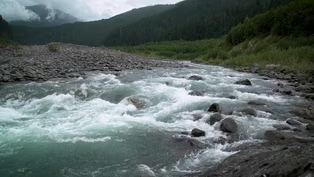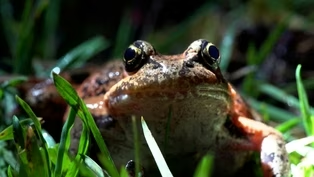Oregon Field Guide
Finding black holes
Clip: Season 36 Episode 3 | 9m 30sVideo has Closed Captions
Scientists search for colliding black holes from the windy steppe of eastern Washington.
When two black holes collide in deep space, they momentarily release more power than all the stars in the universe combined. That energy warps space and time, traveling through the universe as a gravitational wave. By the time they reach Earth, the waves are impossibly faint. But scientists in eastern Washington have built a cutting edge instrument that is revealing the universe as never before.
Problems playing video? | Closed Captioning Feedback
Problems playing video? | Closed Captioning Feedback
Oregon Field Guide is a local public television program presented by OPB
Oregon Field Guide
Finding black holes
Clip: Season 36 Episode 3 | 9m 30sVideo has Closed Captions
When two black holes collide in deep space, they momentarily release more power than all the stars in the universe combined. That energy warps space and time, traveling through the universe as a gravitational wave. By the time they reach Earth, the waves are impossibly faint. But scientists in eastern Washington have built a cutting edge instrument that is revealing the universe as never before.
Problems playing video? | Closed Captioning Feedback
How to Watch Oregon Field Guide
Oregon Field Guide is available to stream on pbs.org and the free PBS App, available on iPhone, Apple TV, Android TV, Android smartphones, Amazon Fire TV, Amazon Fire Tablet, Roku, Samsung Smart TV, and Vizio.
Providing Support for PBS.org
Learn Moreabout PBS online sponsorship(birds chirping) (wind whooshing) - [Narrator] In the shrub steppe lands of Eastern Washington just down the road from one of the birthplaces of the atomic bomb, two four-kilometer long tunnels meet at a perfect right angle.
Inside, is one of the most sensitive instruments humans have ever built, meant to detect some of the most powerful events in the entire universe, and today it's getting an upgrade.
- You could do a ton of planning, and at the end of the day, you're kind of like, "I'll just go in there and I'll figure it out," today is a go in there and figure it out day.
- [Narrator] Welcome to the Laser Interferometer Gravitational-Wave Observatory, which most folks around here know as LIGO.
- We bring essentially a whole new sense to the astronomy game.
We are listening to the universe where we have only seen the universe prior to now.
- [Narrator] Telescopes look at light, but what LIGO looks for can't be seen.
When two very dense objects, like black holes or neutron stars, collide out in space, for a brief moment, they release more power than all of the stars in the universe combined.
This creates waves that squish and stretch space itself.
These gravitational waves spread out and just like sounds are harder to hear the farther away you are.
- By the time the energy from those huge gigantic explosions, billions of light years away get to Earth, they are incredibly weak.
So the challenge is trying to create a detection system that would be able to measure such an incredibly small change in space time.
- [Narrator] Which means you need a very sensitive detector.
LIGO works by shooting an infrared laser beam down the entire length of both perpendicular arms.
The beams bounce back and meet in the middle.
When a wave passes through, it changes the length of each arm differently, which throws the laser light in between just a tiny bit out of sync.
LIGO Hanford has a twin, an almost identical facility in Livingston, Louisiana.
This allows astronomers to measure a wave twice as it passes through the Earth, helping them to understand what caused it and where it came from.
These waves are the signal of some of the most powerful events in the universe, but for all of human history, we couldn't detect them Until 2015.
- We have detected gravitational waves, we did it.
(audience applauding) - [Narrator] The frequencies of the waves are in the range of human hearing.
With some computer processing and a lot of amplification, they sound like this.
(waves whooshing) It goes by pretty quick, here it is again.
(waves whooshing) That sound, recorded early in the morning at this mysterious facility in far flung Eastern Washington, won the team a Nobel Prize in physics.
Since then, other detectors have come online in Italy and Japan, and together, they've detected dozens of collisions, every one of them a tiny blip from hundreds of millions of light years away.
Measuring something so small requires incredibly precise engineering, but the landscape around Hanford provided the right raw materials.
- [Jeff] The bigger you make the arms, the more sensitive you are to that change in space time.
Hanford is wonderful because it's flat, it's relatively easy to make four kilometers of very flat land.
- [Narrator] Then you need one of the world's largest vacuum chambers, massive shock absorbers, and a way to control a boggling variety of mirrors, motors, and circuits.
And after all that, Eastern Washington has its own special challenges.
- We get these big winds here in the Tri-Cities and 30-40 mile an hour routinely, and it wants to pull the buildings around.
And so, wind for us is a direct contribution to how the machine works.
- [Narrator] And the local wildlife.
- A noise source that ended up being related to crows pecking away at ice on one of the tanks that's exterior to us, rattlesnakes maybe has been in the building twice.
We get a lot of porcupines.
Yesterday, we gave a little tour, oh, coyote.
Here he comes.
He's pretty healthy looking.
He is just hanging out.
Oh, that's funny.
- That's amazing.
- Yeah, well.
- That's so perfect.
- On cue.
- Yeah, exactly.
- Planned that, brought him with me.
- Talking about critters, yeah.
- [Betsy] Whenever you put anything on natural land, you know, things just want to come in.
- [Narrator] For as wild as the outside can be, the inside is one of the most pristine and controlled environments on Earth.
- I would say, when I first started working on the actual components of the detector, I was nervous about cleanliness.
I am a dirty person, we are all dirty humans, and this detector requires very clean stuff.
- [Narrator] The most sensitive parts of the detector are kept in a vacuum, off limits to humans.
They only open the chamber every few years for maintenance and to make upgrades that they hope will let them hear more distant collisions and more of them.
It's heady stuff, this thing right here is part of a new quantum light squeezer.
The scientists think it will give them a clearer signal, but getting it set up will take months of precise work.
It often comes down to solving familiar problems in the moment.
- When I first started LIGO, I thought for sure it was going to be like "Minority Report", doing all this like virtual stuff, and I crack up because, at the end of the day, you're like, did you try this one?
(laughs) - [Narrator] Today, they're trying to remove a small window that was causing some interference, - [Betsy] Huh.
- [Narrator] But it won't budge.
- Set screws and nuts are not my favorite thing.
It's like coal at Christmas.
Maybe we should go with plan B.
We never have a can't do moment, we almost always can fix anything.
Now, let's be very careful because the window may come flying right out.
- Just remember that it's 30 pounds.
- Oh yeah, okay, good.
- There's thousands of parts with thousands of bolts, all different sizes, all designed by disparate engineering teams across the entire world.
- [Betsy] Okay, we got it?
- [Jeff] When you get in chamber.
you have to make it work.
- All right.
We would've liked to remove the whole assembly, but we're going to get to that later.
But at least now, our beam's shooting straight through here.
(footsteps tapping) (birds chirping) - [Narrator] When we came back a year later, LIGO was listening deeper into space and hearing more collisions than ever before.
The team even detected a potential collision just hours before we arrived.
- This morning at 4 something AM in my time zone, we had a gravitational wave candidate come through.
It's quite high probability that it was two black holes spiraling around each other and then collapsing and merging into one final black hole.
- [Narrator] What once won the Nobel Prize is now a weekly occurrence.
- [Machine] Again, ray burst short.
- Camera ray burst.
- So this could be good.
- [Camilla] Mm-hm.
You don't want to say boring, but it's that good kind of normal that we get really exquisite gravitational wave candidates every three days or so.
- We're detecting event after event, we are now a gravitational wave factory, - [Narrator] But this is still a complex machine.
- There's a lot of things that we can't control for, like there's an earthquake in the other side of the world.
Everything kind of shakes out of alignment too much.
There's like so many problems, like, it could just be busy all the time and we are.
- [Narrator] What's next for LIGO?
- [Betsy] Even though we just started this run, we're already planning the upgrades that will get us more range.
- Gravitational wave astronomy is still a really new and exciting field, it's really wonderful to be a part of something that feels kind of cataclysmic, in terms of just shifting the way we think about physics.
- We really have opened up a new corner of astronomy.
So, yeah, it's a great time to be a gravitational wave astronomer.
(birds chirping) (wind whooshing) (no audio) - Getting inspiration for your next adventure, it's kind of why you're here, right?
Well, you can support more of what we do on "Oregon Field Guide" and everything else you see on OPB, by going to opb.org/video becoming a sustaining member.
(bright music)
Elwha River rebounds after dam removal
Video has Closed Captions
Clip: S36 Ep3 | 9m 58s | Witness the Elwha River’s recovery 12 years after dam removal. (9m 58s)
Video has Closed Captions
Clip: S36 Ep3 | 8m 16s | Red-legged frogs cross a busy Portland highway with help from the “Frog Taxi.” (8m 16s)
Providing Support for PBS.org
Learn Moreabout PBS online sponsorshipSupport for PBS provided by:
Oregon Field Guide is a local public television program presented by OPB

















